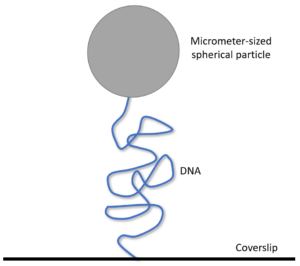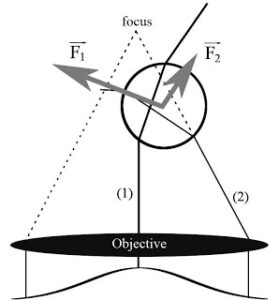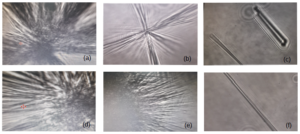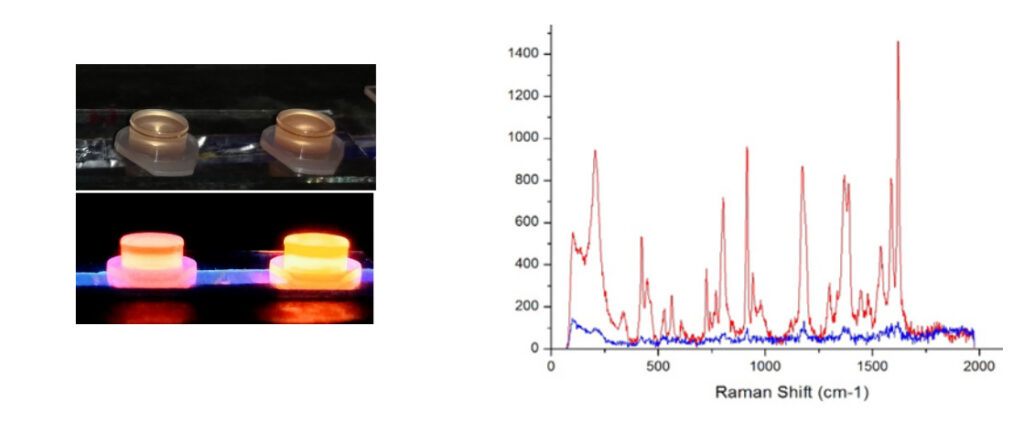Research Lines
DNA-LIGAND INTERACTIONS
Objectives: Investigation of the DNA interactions with drugs, proteins and other ligands by using the techniques of optical and magnetic tweezers, videomicroscopy, DLS, fluorescence microscopy, gel electrophoresis and atomic force microscopy. Characterization of the mechanical and physicochemical properties of the complexes formed.

The study of DNA interactions with ligands is an interdisciplinary field of knowledge, involving physics, biology, chemistry, biochemistry, medicine, etc. Among the main motivations for studying these systems, we can mention:
a) Understanding the molecular details of some basic intracellular mechanisms, such as the DNA replication and compaction, transcription, protein translation, among others.
b) Understanding the mechanisms of action of drugs used in the treatment of human diseases, especially in chemotherapies and gene therapies. Development of new drugs and / or protocols to enhance the efficiency of these therapies.
CELL DYNAMICS
Objectives: To study the processes involved in the dynamics of migration, aggregation and membrane activity of normal and cancer cells in culture, with the experimental techniques of videomicroscopy, optical tweezers and fluorescence microscopy. Statistical analysis and modeling of the processes involved.

The growth patterns generated by cells in culture are associated with the scaling laws that govern the evolution of these cells. As such scaling laws emerge from the dynamics of cell division and aggregation, they should reflect the functional properties of cells and their interactions with the microenvironment in which they live. It is known that, in general, normal and cancerous cells have different patterns of growth, migration, aggregation and so on. Therefore, the study of phenomena related to these properties may aid the development of drugs and treatments more effective against cancer.
OPTICAL TRAPPING, MANIPULATION AND APPLICATION TO NEW MATERIALS
Objectives: Calibration and improvement of the methods used for optical trapping and manipulation of micrometer-sized systems. Applications for biological systems and microfluidics. Optical trapping and manipulation of new materials (topological insulators, semiconductors, etc.).

MICRORHEOLOGY WITH OPTICAL TWEEZERS
Objectives: To study and characterize the viscoelastic behavior and properties of general soft matter systems.

EXPERIMENTAL STOCHASTIC THERMODYNAMICS
Objectives: This research line aims to experimentally investigate the thermodynamics of mesoscopic systems far from equilibrium, with emphasis on state transitions, microscopic heat engines, and active matter. Optical tweezers are employed to trap and manipulate single microparticles—ranging from passive colloids to motile bacteria—allowing direct access to thermodynamic observables that fluctuate over time. The research addresses the role of information in extractable work, the energetic and entropic costs of transformations, and the characterization of single-particle active matter. The ultimate goal is to establish experimental platforms capable of precise measurements of work, power, entropy production, and mutual information, providing quantitative links between stochastic dynamics, fluctuations, and system performance.

OPTICAL BIOPSY
Objectives: To investigate pathological biological tissue and/or cells culture using optical techniques to provide diagnostic information. In particular, the use of fluorescence microscopy and micro-Raman spectroscopy to study biological samples and evaluate the structural and molecular alterations caused pathologies.

The term optical biopsy is nowadays common among researchers in the field of biomedical optics, although it is inaccurate since biopsy refers specifically to the removal of tissue. Regardless, optical biopsy is commonly understood to denote the use of optical techniques, such as spectroscopy, to perform a minimally invasively tissue diagnosis. The motivation to study and perform optical biopsy is to provide the same diagnostic and, sometimes, provide supplementary pathology information without the need of surgical removal of tissue.
BIOMARKERS AND SERS SUBSTRATES FOR BIOLOGY
Objectives: To develop and apply optical biomarkers for fluorescence microscopy of biological samples by using biofunctionalized quantum dots. Also, to develop and apply surface-enhanced Raman spectroscopy substrates using metallic nanoparticles to evaluate biological samples by Raman spectroscopy.
External fluorescent marker molecules which specifically bind to the structures of interest can be use as labels. Quantum dots have size-tunable absorption and emission, extremely broad and intense absorption, high fluorescence quantum yields and large two-photon action cross-sections when compared to established organic dyes.
In SERS, metallic nanoparticles interact with the light generating an enhanced electric field near the metal surface. When a target molecule is near these surfaces the Raman scattering is markedly enhanced. A challenge for live-cell imaging using Raman microscopy has been long imaging times owing to the weak Raman signal. Thus, SERS has been widely used in biomedical applications because of its high-sensitivity detection and molecular selectivity.
OPTICS APPLIED TO PHARMACOLOGY
Objectives: To investigate efficacy, quality and safety of treatments using new drugs or natural extracts by optical methods. In addition, to analyze the quality and safety of food products by optical methods, specifically fluorescence microscopy and Raman spectroscopy.

